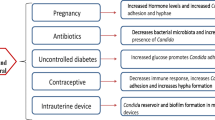Abstract
Recurrent vulvovaginal candidiasis (RVVC) is by no means uncommon and is a source of considerable physical suffering, in addition to serving as a major therapeutic challenge. The syndrome is multifactorial in etiology, hence management strategies must recognize the complex etiologic pathways. Considerable progress has been made in identifying secondary causes, including biologic and host factors. Specifically, Candida microbiologic studies have revealed that azole resistance in Candida albicans is rare and infection by less sensitive non-albicans Candida species is uncommon. At least half the women with RVVC have no identifiable host or microbial predisposing factors, and an immune-based hypothesis has been generated.
Similar content being viewed by others
References and Recommended Reading
Sobel JD: Epidemiology and pathogenesis of recurrent vulvovaginal candidiasis. Am J Obstet Gynecol 1985, 152:924–935.
Foxman B, Marsh JV, Gillespie B, et al.: Frequency and response to vaginal symptoms among white and black women: Results of a random digital dialing survey. J Women’s Health 1998, 7:1167–1174.
Sobel JD, Faro S, Force RW, et al.: Vulvovaginal candidiasis: Epidemiologic, diagnostic, and therapeutic considerations. Am J Obstet Gynecol 1998, 178:203–211.
Sobel JD, Kapernik P, Zervos M, et al.: Treatment of complicated Candida vaginitis: Comparison of single and sequential doses of fluconazole. Am J Obstet Gynecol 2001, 185:363–369. This large, prospective, randomized, controlled study served to validate the recommendation that severe and recurrent infections and those infections caused by non-albicans species should be considered complicated.
Giraldo P, von Nowaskonski A, Gomes FA, Linhares I, et al.: Vaginal colonization by Candida in asymptomatic women with and without a history of recurrent vulvovaginal candidiasis. Obstet Gynecol 2000, 95:413–416.
Ohmit SE, Sobel JD, Schuman P, Duerr A, et al.: A longitudinal study of mucosal Candida colonization and candidiasis among HIV-seropositive and at-risk HIV-seronegative women. J Infect Dis 2002, In press.
Vazquez JA, Sobel JD, Demitriou R, et al.: Karotyping of C. albicans obtained longitudinally in women with recurrent vulvovaginal candidiasis. J Infect Dis 1994, 170:1566–1569.
Barousse MM, Steele C, Dunlap K, Espinosa T, et al.: Growth inhibition of Candida albicans by human vaginal epithelial cells. J Infect Dis 2001, 184:1489–1493.
Fidel PL Jr, Sobel JD: Host defense against vaginal candidiasis. In In Candida and Candidiasis, edn 1. Washington, DC: ASM Press; 2002:193–209 Comprehensive review of host defenses and mechanisms responsible for both prevention and exacerbation of Candida vaginitis.
Lynch ME, Sobel JD: Comparative in vitro activity of antimycotic against pathogenic vaginal yeast isolates. J Med Vet Mycol 1994, 32:267–274.
DeLeon EM, Jacober SJ, Sobel JD, Foxman B: Prevalence and risk factors for vaginal Candida colonization in women with type I and II diabetes. BMC Infect Dis 2002, 2:1–11.
Reed BD, Gorenflo DW, Gillespie BW, et al.: Sexual behavior as risk factors for Candida vulvovaginitis. J Womens Health Gend Med 2000, 9:645–655. Excellent review and delineation of sexual behavior that is responsible for some women acquiring RVVC.
Sobel JD, Ohmit SE, Schuman P, et al.: The evolution of Candida species and fluconazole susceptibility among oral and vaginal isolates recovered frorm HIV-seropositive and atrisk seronegative women. J Infect Dis 2001, 182:286–293.
Fong IW: The value of treating the sexual partners of women with recurrent vaginal candidiasis with ketoconazole. Genitourin Med 1992, 68:174–176.
Spinillo A, Carratta L, Pizzoli G, et al.: Recurrent vaginal candidiasis. Results of a cohort study of sexual transmission and intestinal reservoir. J Reprod Med 1992, 37:343–347.
Chaim W, Foxman B, Sobel JD: Association of recurrent vaginal Candidiasis and secretary ABO and Lewis phenotype. J Infect Dis 1997, 176:828–830.
Ashman RB, Fulurija A, Papadimitriou JM: Strain-dependent differences - host response to Candida albicans infection in mice are related to organ susceptibility and infection load. Infect Immun 1996, 64:1866–1869.
Hilton E, Isenberg HD, Alperstein P, et al.: Ingestion of yogurt containing Lactobacillus acidophilus as prophylaxis for candidal vaginitis. Ann Intern Med 1992, 116:353–357.
Sobel JD, Chaim W: Vaginal microbiology of women with acute recurrent vulvovaginal candidiasis. J Clin Microbiol 1996, 34:2497–2502.
Antonio MA, Hawes SE, Hillier SL: The identification of vaginal hactobacellus species and the demographic and microbiologic characteristics of women colonized by these species. J Infect Dis 1999, 180:1950–1956.
Donders GGG, Renen H, Reybrouck R: Impaired tolerance for glucose in women with recurrent vaginal candidiasis. Obstet Gynecol 2002, In press. Important contribution identifying yet another risk factor in nondiabetic women for recurrent infection.
Fidel PL Jr, Sobel JD: Immunopathogenesis of recurrent vulvovaginal candidiasis. Clin Microbiol Rev 1996, 9:335–348.
Picinni MP, Vultaggic A, Scaletti C, et al.: Type 1 T Helper cells specific for Candida albicans antigens in peripheral blood and vaginal mucosa of women with recurrent vaginal candidiasis. J Infect Dis 2002, 186:87–93.
Rosedale N, Braue K: Hyposensitization in the management of recurring vaginal candidiasis. Ann Allergy 1979, 43:250–253.
Rigg D, Miller MM, Metzger WJ: Recurrent allergic vulvovaginitis treatment with Candida albicans sllergen immunotherapy. Am J Obstet Gynecol 1990, 162:332–339.
Author information
Authors and Affiliations
Rights and permissions
About this article
Cite this article
Sobel, J.D. Pathogenesis of recurrent vulvovaginal candidiasis. Curr Infect Dis Rep 4, 514–519 (2002). https://doi.org/10.1007/s11908-002-0038-7
Issue Date:
DOI: https://doi.org/10.1007/s11908-002-0038-7



